Rescue Mission in Tioman
Beautiful Tioman seen from the Paya beach jetty.
The Course
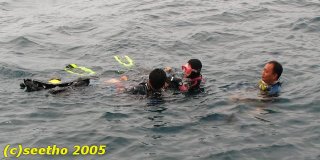
Sachi and I taking turns giving rescue breaths every 5 seconds to Agnes the “victim” while swimming back to the boat. I actually had cramps on my left thigh half to struggle with during to long swim back to the boat.
Quick check of vitals, 2 cycles of CPR…

…some oxygen from a DAN kit…
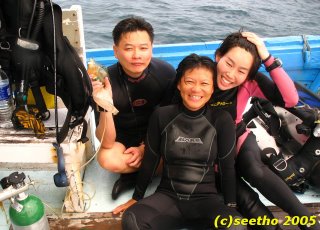
…and the victim miraculously recovers. Smiles all round. (I could use some of that oxygen at this point.)

A refreshing dip in the cool waters of a stream behind Tioman Paya Resort after all the hard work sure feels good.
Now for Some Fun
The dive at Sea Fan Garden was really a joke. We did not manage to see a single sea fan. Apparently the guide did not know the exact location and took us to the wrong spot.
I seen these juvenile yellow boxfish – Ostracion cubicus, on several occasions but each time failed to take a decent photo. This time I managed a reasonable shot. They are extremely shy fishes.
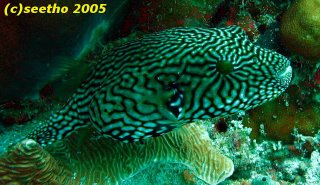
A young map puffer – Arothon mappa, identified by radial spoke patterns around the eyes.
Phyllidia elegans.
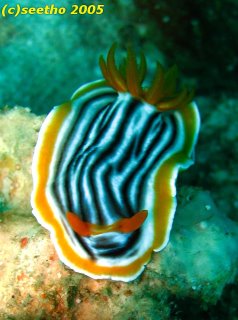
A beautiful Chromodoris magnifica.
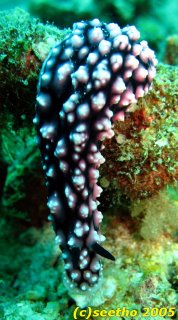
Phyllidiella pustulosa.
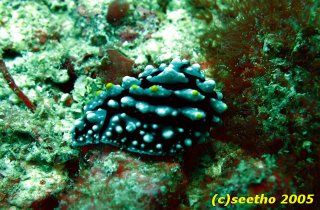
Phyllidiidae family nudibranch. This is the only clear shot I managed so it’s difficult to tell exactly what species it is.
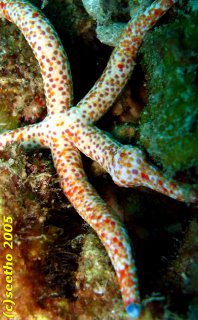
A small Linckia multifora with a strange lump on one of its limb. It’s probably been bitten off. If the other limb did not end up as lunch it will probably regenerate into another total new starfish.

Beautiful green bubble coral - Plerogyra sinuosa.
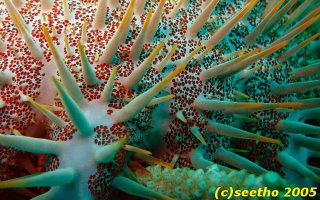
Close up of a crown of thorns – Acanthaster planci, devouring staghorn corals. They contain a toxic compounds called saponins which may cause extreme pain and swelling. Some people may have allergic reactions towards these toxins making the wounds heal very slowly so be careful when near them.
The dive at Pulau Renggis was also not so fun. Unfortunately another guest at the Sealantis dive center came along for this dive. He was taking his DM certification and being a typically loud and pushy American he was “policing” us throughout the dive as if it was a secret navy operation to flush out terrorist hiding among the staghorn corals. I really could not take my time to get any good pictures.
A baby Fromia monolis.
A very small Heteractis magnifica flapping around in very strong current on coral rubble at 5m. Hopefully it survives long enough to host some clown fishes of its own on day.
Sailor’s eyeball algae – Ventricaria ventricosa. The largest single celled algae in the world. These are about marble sized, spotted during my safety stop at 5m. They grow to about 50mm and can be found anywhere up to 20m depth. It feels like very tough and smooth rubber balls with a metallic sheen. I thought they where discarded plastic the first time I picked one up when I was diving in
A Word about the Accomodation
Tioman Paya Resort was expensive for the quality of the rooms and food - definitely not recommended for those planning to stay at Paya beach. The Neighboring Paya Beach Resort is much better but always seems to be fully booked all the time.
I’ll be Back
No time for photos again; but I’ll be back. Tioman is after all the nearest place from KL for good diving spots. 4 hours drive and 2 hours on the speed boat – anything for some Nitrogen!

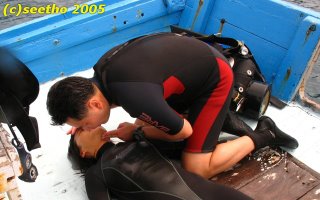
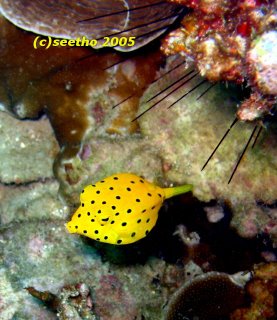

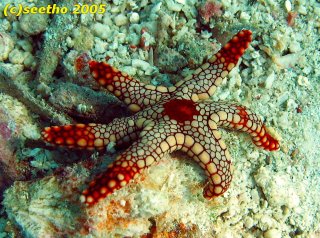

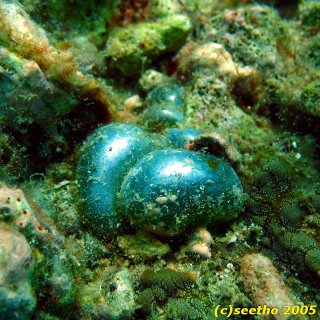

1 Comments:
FINALLY! Another beautiful blog from you! Hahaha... Congrates on being a Rescue Diver. Keep it up & always keep up-to-date with your rescue knwledge & skills. Many divers I know tend to "throw" everything they learnt back into the sea. They tot learning & getting certified is enough to prepare them for emergencies. So, don't do the same mistake! Bravo to u both. Catch up sometime soon.
Post a Comment
<< Home